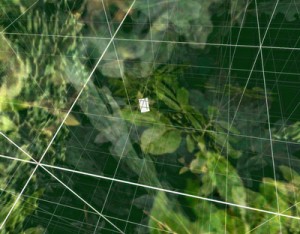Immersive Virtual Art and the Essence of Spatiality

"This progression was fueled not by an interest in technology but by her search for a medium more capable of realizing her artistic intent: namely, the shifting of perception beyond habitual looking-at the world as object (and image) to increasing awareness of being bodily present in the world with all its flux." - Char Davies / Artist Statement 2007
Davies completed a Ph.D. through the Planetary Collegium, her thesis titled Landscapes of Ephemeral Embrace: A Painter's Exploration of Immersive Virtual Space as a Medium for Transforming Perception.
McRobert claims that Davies' art brings us face to face with an experience of space-time that we intuitively know but had no way of consciously accessing until now. Her art is the medium that moves us to a state of consciousness that is closer to our emotions and fears and biological founded intuition. In order to create a heightened sense in the participant, she persuades him to be still. In contrast to most interactive works, she embraces stillness and rewards the users with high resolution visuals when not moving. She also uses sensors that integrate the participants breathing as a mode of interaction. This connects the participants closer to their bodies, and their bodily experience in the virtual space. It tries to make us consciously experience the unconscious, by immersing us in an instinctive nucleus of emotion that has to do with knowing through bodily being, rather than knowing noetically, abstractly. Her art is mental exercise and physical experience at the same time.
Physicist Steven Weinberg states that we are imaginatively constrained by mathematical notions. ('A Unified Physics by 2050', 1999)
"How do we get beyond our present intuitions of space-time and move forward imaginatively into another dimension of spacetime?"
McRobert writes that there is a need today to access higher conscious states of mind, that differs from the normal state associated with everyday living. It has been proven that individuals derive most creative scientific formulas and ideas for works of art during dreams or drug ingestion. Including immersive virtual environments as a category for possible doors of perception, can give new ways of accessing this higher order of consciousness.

Disorienting Experiences
- Howard Rheingold - Sense of self, of seeing a remote presence of oneself in VR
- almost human looks, intensely disturbing
- Isabella Delmotte: Epileptograph.
Art inspired by epileptic seizures, shall communicate states of consciousness while in a seizure
Doors of Perception
Looking at flickering lights has the power to alter your state of consciousness. It is the unpredictability in motion that hypnotizes us. It can happen while looking at the fire, or single flames, the flickering of sunlight through leaves or on the water, or the flickering of the dotted lines on the road while driving - repetitive light patterns have a hypnotic quality that can cause our brainwaves to go into alpha or theta rhythms. These frequencies are typical for meditative or dream-like states. This altered state of consciousness is soothing and calming.